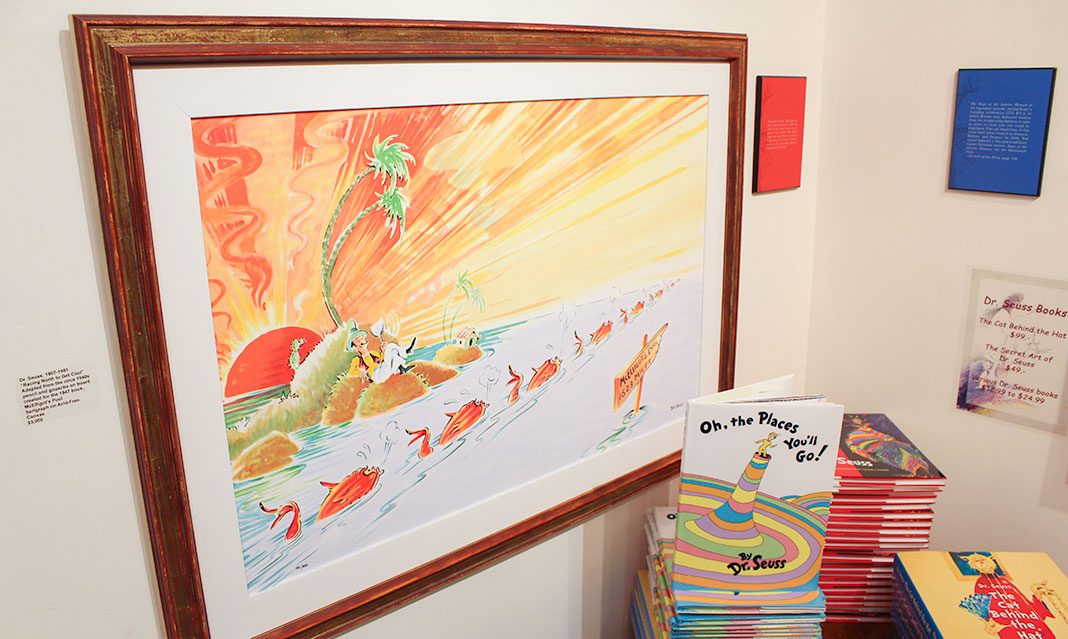The whimsical stories of children’s author Theodor Seuss Geisel, better known as Dr. Seuss, introduced generations to imaginative worlds, while also teaching them the power of reading. Dr. Seuss’ illustrations of his most known works, such as “The Cat in the Hat,” as well as previously unseen work pieces were exhibited at Toronto’s Liss Gallery.
Geisel was an aspiring artist growing up. While attending Dartmouth College, he contributed to the college humour magazine, The Jack-O-Lantern, where his pen name began. Geisel was caught drinking with other Dartmouth students during the prohibition era of the 1920s and was banned from contributing to the magazine. Defiant, he would continue to publish under his mother’s maiden name, Seuss.
The exhibition included rough sketches and drafts of Geisel’s books. The attention to detail and the emphasis he had with colour is highlighted in select pieces. Geisel meticulously illustrated and wrote every draft of his books. He would include specific instructions regarding the colour and tones so the printing house could bring his visions to life.
In a preliminary draft of “The Cat in the Hat” that was displayed, Geisel scribbled in the margins the specific percentage of gray scale needed below the characters necktie. These small details show the mind of an artist at work, ensuring each aspect is true to form.
The drafts and large-scaled illustrations displayed are not original pieces from Geisel, but are authorized reproductions that were done by artists using similar methods. Original Dr. Seuss drafts and illustrations exist in libraries that are authorized by the Geisel family or in the family’s archive.
Along with the familiar works under the Dr. Seuss pen name, “The Secret Art of Dr. Seuss” collection is the highlight of the exhibition. The collection displays pieces Geisel created in private that do not adhere to the traditional style or subject matter he is known for.
Before Geisel died in 1991, he shared with his wife Audrey the wish for her to show the public his private work. Geisel was a more serious artist in his private life and he wanted his fans to see all aspects of his creativity after he passed away.
The reproduced pieces in this collection show a different side of Geisel, but his style is still evident. In the 1930 painting “Abduction of the Sabine Women,” Geisel depicts the ordeal of the founding of Rome when Roman men would visit the adjacent Sabines and kidnap women to take as their wives. This harrowing subject matter is paired with Geisel’s well-known style of exaggerated aesthetic of characters with animals peering in and watching the ordeal take place.
The private pieces also display the more complex techniques Geisel had with detailed images of fish swimming upstream in “Joyous Leaping of Uncanned Salmon.” This is far from the simple illustrations that were prominent in his popular book “One Fish, Two Fish, Red Fish, Blue Fish.”
The juxtaposing collections showcased the private and public creativity of Geisel. It signifies an artist’s ability to go beyond their popular aesthetic and express their creativity in any form.
The child-like wonder and imagination in the exhibition unveils the journey of Geisel and his Dr. Seuss persona.




January 8, 2018
The Art of Dr. Seuss, from The Chase Group, Dr. Seuss Enterprise and participating galleries, is fraud.
The so-called “art,” has been and continues to be misleadingly represented, by the principals listed above, as original works of visual art i.e., lithographs, serigraphs, edition sculpture and other mediums, falsely attributed to Theodor Geisel with counterfeit “Dr. Seuss” signatures in bogus numbered editions.
Caveat Emptor!
Gary Arseneau
artist, creator of original lithographs
[who researches and publishes on issues of authenticity
Fernandina Beach, Florida